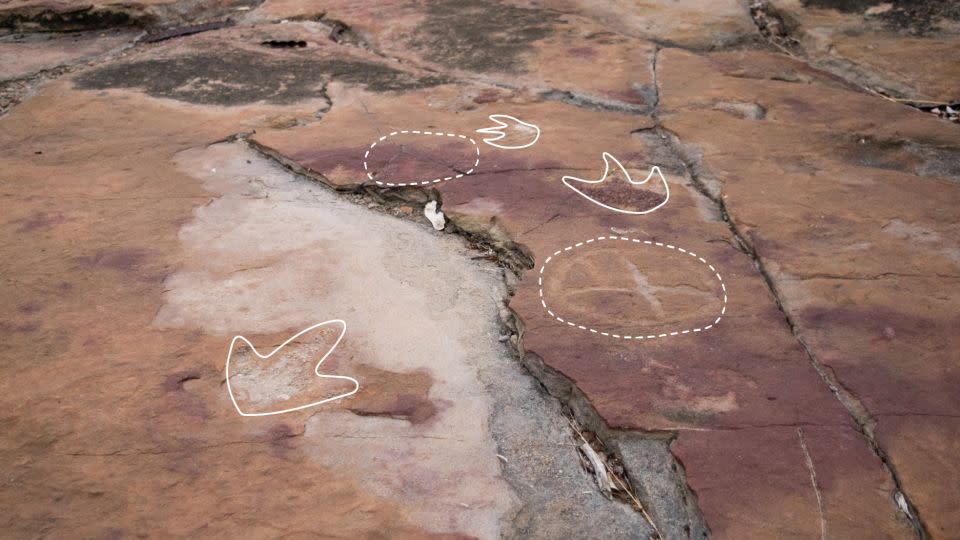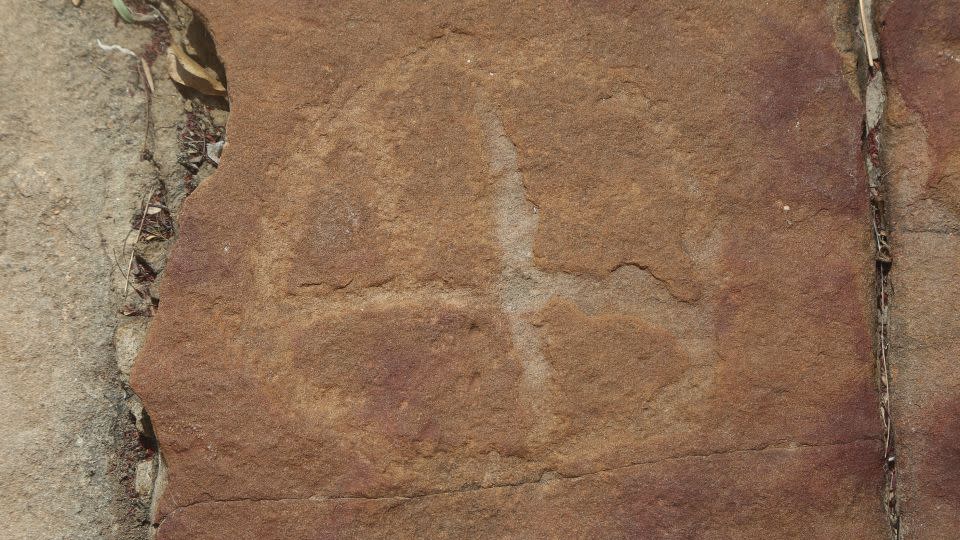Sign up for CNN’s Wonder Theory science newsletter. Explore the universe with news about fascinating discoveries, scientific breakthroughs and more.
Prehistoric humans in Brazil carved designs into the rock alongside dinosaur footprints, suggesting they may have found them significant or interesting, a new study finds.
The rock carvings, which archaeologists call petroglyphs, are at a site called Serrote do Letreiro, in Paraíba, an agricultural state in the far east of Brazil. Researchers first observed the markings in 1975. But they are now interpreted as related to footprints, following recent drone-assisted field surveys that discovered never-before-seen carvings. The footprints belong to dinosaurs from the Cretaceous Period, which ended 66 million years ago.
“People generally think that indigenous people didn’t know their surroundings or didn’t have any kind of scientific spirit or curiosity,” said study co-author Leonardo Troiano, an archaeologist at the Instituto do Patrimônio Histórico e Artístico Nacional in Brasília. “But that is not true. It is very clear that they were interested in the footprints. We will never know if they knew about dinosaurs, but it’s clear they were curious about the footprints and thought they were significant in some way.”
The Serrote do Letreiro petroglyphs are not the first examples of rock art found near dinosaur tracks, but the study authors said they believe the unprecedented clarity of the association between the two at this particular site could have significant implications across paleontology. . archeology and cultural heritage studies.

Geometric shapes
It is unclear how long ago the petroglyphs were made. But the study – published in March in the journal Scientific Reports — notes that radiocarbon dating has found that cemeteries in the area are between 9,400 and 2,620 years old, suggesting that the tribes that left them must have lived at that time.
“These people probably lived in small communities, using natural rock shelters that are very abundant in the area,” Troiano said.
“This region of Brazil is like the Outback of Australia: it’s very hot and there’s no shade, so it’s not easy to stay there and carve the rock. It takes a lot of effort, so when they chose this location they were very intentional,” she added. “They could have used so many other rock outcrops nearby, but they chose this one.”
The drawings have varied styles, suggesting that several artists may have participated in them. Some have shapes that resemble plants, while others resemble geometric shapes, including squares, rectangles, and circles. The circles have crosses or lines inside them, which can look like stars, Troiano said. However, what these markings mean remains a mystery.
“They all look abstract and if they represented something to the people who created them, we don’t know what it is,” he said.
The footprints of Serrote do Letreiro belong to three types of dinosaurs: theropods, sauropods and ornithopods. Researchers suspect that the people who carved the rock may have mistaken some of them for the footprints of emus – large native birds similar to ostriches that have footprints that look almost identical to those of theropod dinosaurs.
It’s harder to imagine what prehistoric people might have thought of sauropod tracks, left by some of the largest herbivorous dinosaurs that ever lived and therefore unlike any animal they were familiar with. Probably for this reason, an intentional association between the drawings and these specific prints is less clear, the study noted.
Dinosaur rituals
Troiano said he believes the marks may have been left during community meetings.
“I think the creation of rock art was part of some kind of ritual context: people getting together and creating something, perhaps using some psychotropic drugs. We have a plant called jurema, which is hallucinogenic and is still used today,” she said. “We can speculate that people also used it in the past because it is very abundant and common in the region. I think they were interested in what the footprints represent and I assume they identified them as footprints. They realized it wasn’t random.”
There are other sites, Troiano said, with cave paintings in the vicinity of dinosaur tracks – in the United States and Poland – but they do not show “nearly the same level of intentionality,” he said. Intentionality is defined not only by the proximity of the drawings to the prints, but also by whether or not they overlap them. If they don’t overlap, that suggests “consideration” on the part of manufacturers, the study suggests.
Troiano added that he is working on follow-up work that will deepen the interpretation and analysis of the Serrote do Letreiro petroglyphs, based on the findings of the current study.
The drawings’ direct association with fossil dinosaur footprints is unique and could shed more light on the importance, meaning, and significance of rock art, according to Radosław Palonka, associate professor of archeology at Jagiellonian University in Kraków, Poland, who worked in similar studies. petroglyphs, but was not involved in the study.
“The fact that the locations of the rock art panels were specifically chosen is demonstrated, among others, by the fact that representatives of the communities that created cave paintings or petroglyphs often placed them very close to older images left by other cultures,” he said. Palonka. she said in an email. “This has been the case in several parts of the world where rock art has been practiced, and is very clearly visible in, among others, the North American Southwest/Southwest USA, where my scientific interests are concentrated.”


Jan Simek, a distinguished professor of anthropology at the University of Tennessee in Knoxville, agrees. “The paper provides an interesting new example of how ancient people observed and incorporated landscape fossils into their religious experiences and interpretations,” said Simek, who also was not involved in the new petroglyph study.
“Science historian (from Stanford University) Adrienne Mayor has shown how the ancient Greeks and Romans viewed fossils as evidence of giants and monsters from their own mythologies and how North American indigenous peoples viewed their origin narratives in fossils. that they observed scattered across their landscapes,’ Simek said via email. “The case of Brazil is another archaeological example of this very human tendency to link the spiritual world created in the imagination with inexplicable things in the world around us.”
For more news and newsletters from CNN, create an account at CNN.com

































